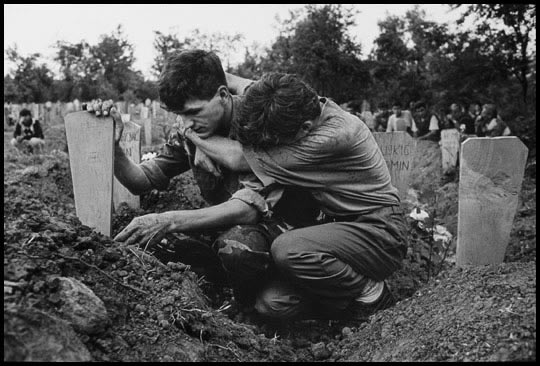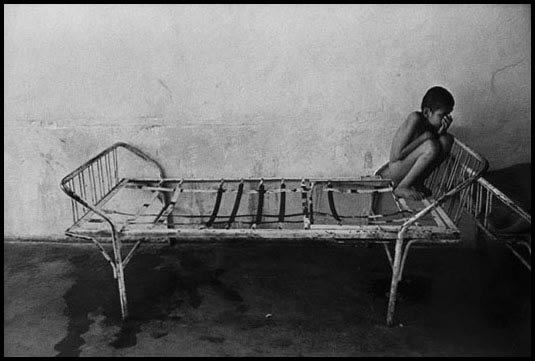Annie Leibovitz and James Nachtwey are both highly talented photographers, famous for their unique and moving photographic styles. Leibovitz is mainly a portrait photographer, and often spends a great deal of time consulting with her subject and arranging the perfect shot. Nachtwey is a war photographer, who has hardly enough time to aim his camera before his subject has moved. However, their strategies are not as different as they first appear. Both of them are artists and have a message they want to convey to their audience, and they use similar methods to achieve this goal.
Leibovitz often spends hours preparing for a shoot, manipulating the lighting, costumes, composition, décor etc to get the look she wants. Her photos do not always look like reality as we know it, but they show us something about reality that we might otherwise have missed. Something about the subject that, despite being at least partially invisible, is an integral part of the subject's character and gives us a deeper understanding of the subject. In order to have so much depth in her photos, she must first get to know her subject and learn who they are and how they want to appear. She spends a great deal of time working with her subjects and thinking about how to set up a shot that will illuminate something about them. Her photos range from simple portraits of members of her family to elaborate scenes with costumes and many people, but she shows the same dedication to each photo and says "I don't have two lives. This is one life, and the personal pictures and the assignment work are all part of it" (quoted from
pbs.org).
 |
| Annie Leibovitz's Mom by Annie Leibovitz (photo borrowed from iwant.on.ca) |
 |
| The Ladies of LA by Annie Leibovitz (photo borrowed from vanityfair.com) |
Nachtwey also photographs a wide range of subjects, but his photos all have a similar theme. They are all about war, sickness, poverty and suffering. He cannot prepare for a shoot because his subjects are not there with the intention of being photographed. Often the action is fast paced and unpredictable, making it impossible to plan the next shot. His goal is to give a voice to the people he photographs in hopes that he can somehow ease their suffering and, because of this, he says that "It's not so much that I want my pictures to be looked upon as art objects as it is a form of communication" (quoted from
imdb.com). But that does not mean he does not use the same skills that Leibovitz uses. In order to communicate what he wants to communicate, he must be in the middle of the action and to do this he must gain the trust of the people around him in the same way that Leibovitz must. If the people around him did not trust him, he would not be able to photograph such intimate moments of people's lives, but because his subjects trust him, and feel he might give them a voice they would not otherwise have, he is able to photograph events he would not otherwise be able to photograph, such as this one:
And, like other artists such as Leibovitz, Nachtwey often makes use of framing and composition to convey the mood of his photos. Like in this one, where the child is very small and viewed from above to convey loneliness and vulnerability.
Overall, whether Nachtwey admits it or not, I think his works are just as much art as the works of Leibovitz or any other artist, and their methods are not all that different, despite the different circumstances. Both Nachtwey and Leibovitz learn as much as they can about their subject so that they can take a more truthful photograph, and they both know that trust is an important part of getting a good picture. There are definitely other things that could be learned from these two photographers, but I think the most important attribute that they share is their ability to earn the trust of their subjects, and use that to create more meaningful photos.




This is a very nice summary and discussion about these two very different photographers. Thanks.
ReplyDelete